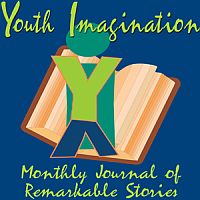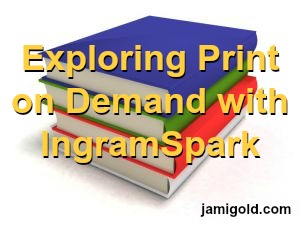A couple of weeks ago, I talked about how we can offer a print version of our book, even if we’re self-published. I have Treasured Claim available at Amazon through their CreateSpace service, but my plan for other retailers is to use IngramSpark for distribution.
Many authors stick with CreateSpace because, as with much of their business approach, Amazon makes things easy and user-friendly. If we check off “Expanded Distribution” in our account, CreateSpace can distribute to other channels, such as bookstores and online retailers.
However, it seems to be hit-or-miss whether bookstores actually want to work with Amazon (the enemy! *smile*) for print copies. So a few authors are now combining what they see as the best of both worlds.
Depending on the specifications of our book, Amazon/CreateSpace’s royalty for in-Amazon sales is often better than what we’d receive for Amazon sales through another distributor. So some authors are sticking with CreateSpace for Amazon sales but distributing to other retailers through the “neutral” IngramSpark, which is part of Lightning Source.
I’m still working on the second part of that plan for the non-Amazon distribution, but my friend Kerry Gans recently went through the print-on-demand (POD) process with IngramSpark, so I asked her to stop by today and share her insights and tips. Please welcome Kerry Gans!
*****
How Lightning Source’s IngramSpark
Compares to Amazon’s CreateSpace
I recently wanted to self-publish a genealogy book for my father’s family. My first stop was Amazon’s CreateSpace, since most people use that service. It seemed simple enough—until I found out that their page limit for color books was 480 pages. My book was 504 pages.
CreateSpace was a no-go.
I then turned to Lightning Source, which I had also heard good things about, although I had been told they were more for small presses, not geared toward self-publishers. However, Lightning Source had recently launched IngramSpark, a service aimed at self-publishers and more user-friendly than Lightning Source proper.
Here’s how the two POD resources compare:
Upfront Costs
The main difference I found between the two is the upfront costs to the service. Spark requires much more upfront money than CreateSpace.
Ingram Spark: Set-Up Charge & Distribution Fee
Spark has a $49 set-up charge for print books and $25 for ebooks (this fee is waived if you have an initial order of 50 books or more). There is also an annual distribution fee of $12 (this fee is waived under certain conditions described below).
IngramSpark: Bring-Your-Own ISBN Required
The largest fee for most self-publishers (at least for those based in the U.S.) will likely be the ISBN fee. Unlike CreateSpace or Smashwords, who allow you to purchase an ISBN through them for a nominal fee, you must provide your own ISBN for Spark.
Buying 10 ISBNs through Bowker cost me $250. But since I know I will use them all eventually, I don’t feel cheated. Honestly, if I had more cash lying around, I would have bought more ISBNs, as the price per ISBN decreases the more you buy.
CreateSpace: None of the Above
I did not get to go through the entire process with CreateSpace, but I believe they were charging $10 for the ISBN and nothing for anything else, so that’s a large difference. (Jami’s note: CreateSpace also allows us to use our own ISBN, so if we choose that route, the ISBN costs would be the same.)
Total for IngramSpark
So, for me to create my genealogy book (printed, not ebook), I paid $299 up front. If you choose to be your own distributor with Spark (known as “short run” distribution), they waive the $12 distribution fee, since you are not using their distribution network. Since my genealogy book is for my family only, this is what I did.
Book Creation
The actual building of your book is very similar in Spark and in CreateSpace. You start by plugging in the metadata they ask for, then upload your interior and cover files.
Your interior for both will be a PDF (based on the submission guidelines they provide). Then you can use their Cover Creator templates to create your cover. While this requires attention to details such as margins, gutters, and bleeds, it is not a difficult task if you take your time.
Book Approval
The e-proof (a PDF) was easy to manipulate, and Spark gives you 3 options: Approve, Approve but don’t distribute until I review a physical copy, and Don’t approve. I ordered a physical copy prior to distribution, and shipping of my order was fast.
When I held that book in my hands, with my name on the cover, representing 20 years of work and reflecting the vision I had for the presentation of all that data, I got chills!
The quality of the final book itself was very good. I am quite pleased with how everything looks. The paper is thick, and the paperback cover is high quality.
Some of the photos were a bit red-yellow, but the ones that looked off were from source materials that were themselves not of the highest quality (such as pictures over 100 years old!), so I suspect the fault was in the source, not the printing. But they were still clear and crisp, and most of the photos and other reproductions were gorgeous.
Distribution
Ingram Spark’s distribution network does get your book where it needs to go: Amazon, B&N, Baker & Taylor (for libraries), and, of course, Ingram itself.
For distribution, Spark requires you to use a wholesale discount of 55% (you can use 40%, but this is discouraged), and you can choose whether to allow returns or not.
I am putting two versions of my genealogy book out to the public—one hard cover, one paperback. The hardback’s cover price is $55; the paperback is $40. If someone bought it directly from me, the price would be closer to $35, depending on shipping. These prices will net me roughly the same profit per book. So if your goal is to get your book to customers at the lowest price, you may need to wear your distributor hat.
If price to your customer is a primary concern for you, take note that I compared the pricing with CreateSpace vs. Spark. Since the public version of this book is only 414 pages, I could use CreateSpace, which was my plan. But when I checked the final price, I would have to charge $60 for the paperback in order to make the same profit as the prices above.
Since CreateSpace does not offer a hardback option, I had to use Spark for that. I couldn’t bring myself to charge $60 for a paperback and $55 for hardback. So even though it cost me a little more up front, I used Spark for both.
Overall Conclusion
Spark has some nice features, including printing calculators and publisher compensation calculators. Although I have found that their FAQs don’t always address my questions (hopefully they will continue to modify them as they get more feedback from clients), I have found their Help staff courteous, knowledgeable, and responsive. You can email them or request a callback. Believe me, I have used their Help staff many times, as I think I have made every mistake possible during this journey!
So this has been my experience with Ingram Spark. It is not quite as user-friendly as CreateSpace, and has more upfront costs, but the support staff was great and the final product was of high quality. Also, Spark seems to have more flexible print options, which might be the key for you.
As to the extra money? The question you need to ask yourself is this: Will I be happy changing my book’s presentation to fit CreateSpace’s needs, or do I want it to be exactly the way I envisioned it?
Ingram Spark will have a lot of work to do to steal market share from CreateSpace, but they have good points that make them a tempting alternative, in spite of the price. They did a good job for me, and I love my book!
*****
 Kerry Gans is the author of the middle grade fantasy The Witch of Zal. She is a chocoholic theater geek, believes libraries are magic, and considers Chincoteague Island her perfect writing retreat. When not writing, she haunts cemeteries and dusty archives in search of long-dead ancestors and pursues her most important work-in-progress, her daughter.
Kerry Gans is the author of the middle grade fantasy The Witch of Zal. She is a chocoholic theater geek, believes libraries are magic, and considers Chincoteague Island her perfect writing retreat. When not writing, she haunts cemeteries and dusty archives in search of long-dead ancestors and pursues her most important work-in-progress, her daughter.
On The Goose’s Quill, she blogs about her journey toward publishing while parenting, and she also writes for the group blog The Author Chronicles. Kerry’s recent publications include the short story Dying Breath and a genealogy reference book The Warren Family of Philadelphia Pennsylvania, and their Ancestors.
For more info or to contact Kerry, check out her website, personal blog, group blog, Facebook, Twitter, Google+, or Goodreads.
*****
 Don’t miss Kerry’s free YA short story, Dying Breath, available for free online through the Youth Imagination ezine. (Jami’s review: It’s beautiful, touching, and made me cry. *smile*)
Don’t miss Kerry’s free YA short story, Dying Breath, available for free online through the Youth Imagination ezine. (Jami’s review: It’s beautiful, touching, and made me cry. *smile*)
A teenage girl with cystic fibrosis gets a miracle—at the price of her estranged brother’s life. Can she find peace even when she feels the wrong sibling died?
*****
Thank you, Kerry! This was a great overview of the pros and cons for dealing with IngramSpark.
I’ve also heard that IngramSpark is the way to go for international print distribution. I believe Amazon currently prints only in the U.S., which requires international shipping to Europe, Australia, etc. However IngramSpark can also print in the UK or Australia, reducing the cost for many international customers.
Also, depending on the specifications of our book, such as number of pages or a color or black-and-white interior, Kerry’s note about Amazon’s costs for printing being higher might not apply for sales within Amazon’s system. (For example, my royalties for CreateSpace print sales within Amazon’s system are over twice what they would be if I went only with IngramSpark and used them to distribute to Amazon.) So be sure to check the specifics for your book before making final decisions.
As with all things in the writing and publishing world, we have to decide what paths and choices makes the most sense for our goals. Hopefully learning more information like this will help us make better-informed decisions. *smile*
Have you considered using IngramSpark? If so, why—what pros and cons have you heard? How does it fit into your publishing strategy? If you’ve worked with IngramSpark, how would you compare the two? Do you have any questions for Kerry?
(P.S. Don’t miss my 5th Blogiversary Contest!)

